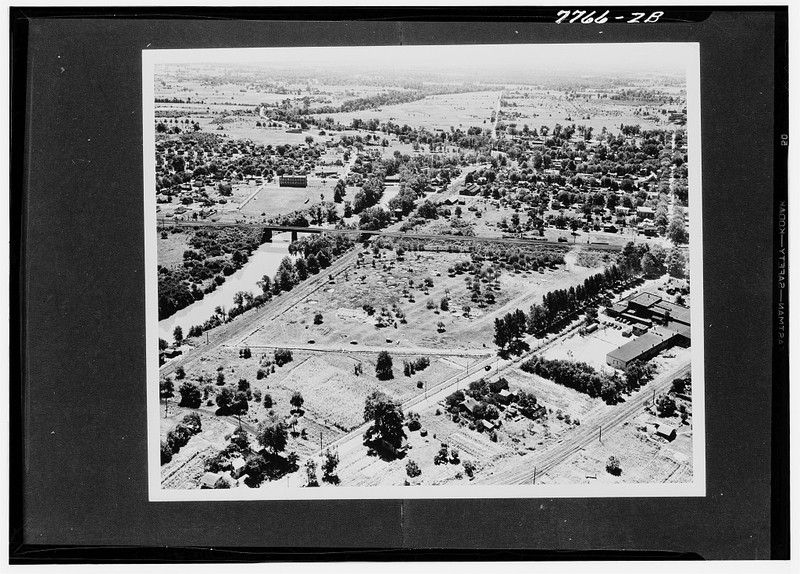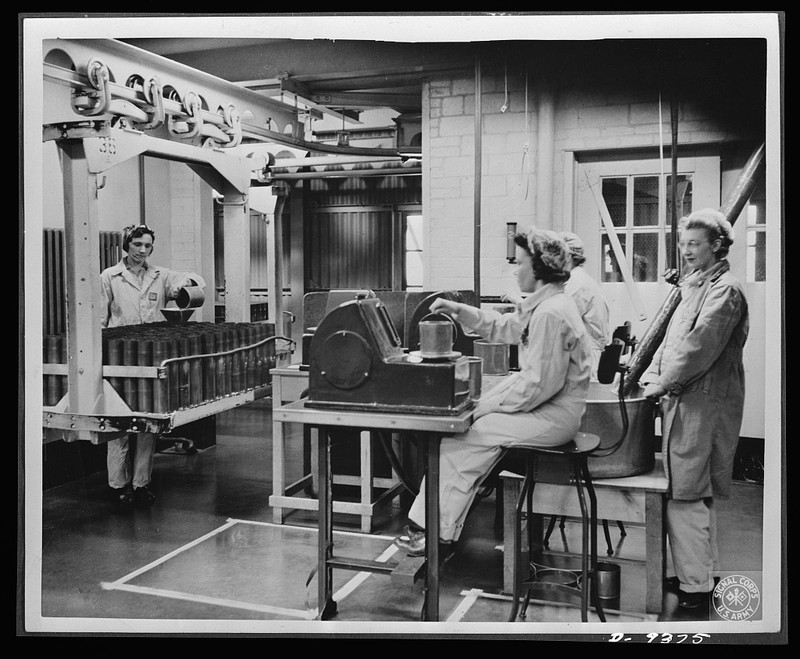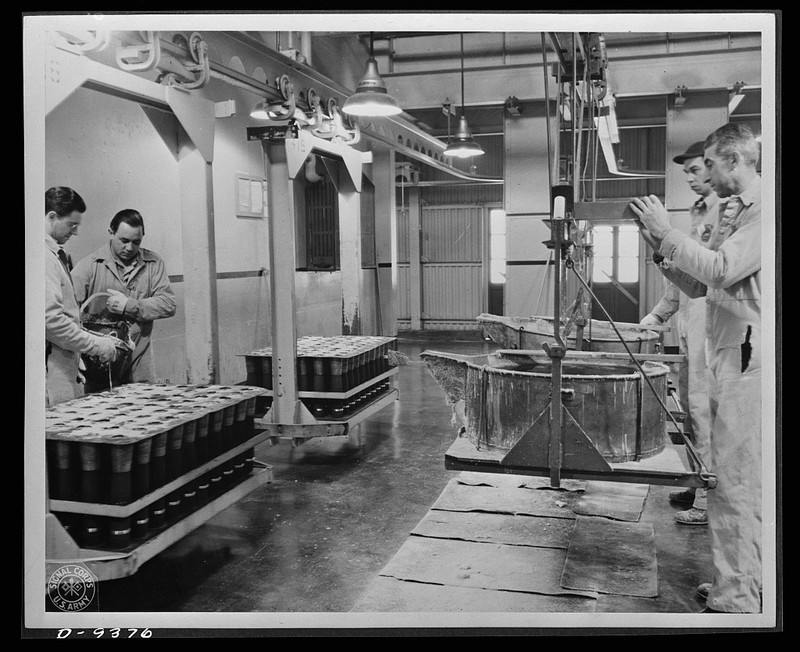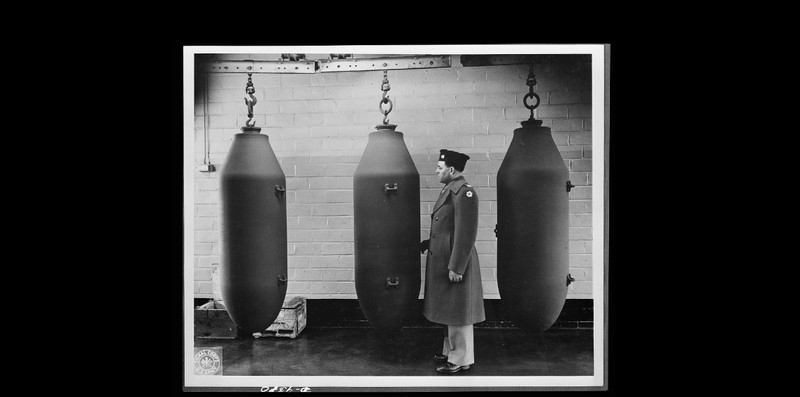Ravenna Arsenal
Introduction
Text-to-speech Audio
The Ravenna Arsenal, also known as the Ravenna Army Ammunitions Plant, was responsible for significant contributions of weapons production for the United States during World War II. They started production in the early 1940s and ceased production with the end of World War II. They also produced arms and ammunition during the United State's participation in the Korean War and Vietnam War. Today, Camp James A. Garfield is located near the arsenal and is used as a military training facility.
Images
Ravenna, Ohio. Ravenna Ordinance Plant.

Production. Shell loading. Ravenna Ordinance Plant

Production. Shell loading. Ravenna Ordinance Plant

Production. Shell loading. Ravenna Ordinance Plant

Backstory and Context
Text-to-speech Audio
The Ravenna Arsenal was established near the start of United Stated involvement in World War II to help with manufacture of arms and ammunition. The location near Ravenna, Ohio was supposedly chosen because it was relatively remote, close to major railroads, and far away from the U.S. coast line, which would have been seen as a major potential target for enemy bombing.
Ravenna Arsenal started production in 1942 and employed over fourteen thousand Ohioans. Their campus was quite expansive with 1,371 buildings located on 21,418 acres. While purpose-built buildings were still under construction, disused houses were used for offices and agricultural structures were used for storage. During World War II, Ravenna Arsenal had the highest weapons production rate in the United States.
On March 24, 1943, there was a major incident at the arsenal. It is unclear exactly what happened, but while explosives were being moved they detonated, resulting in the deaths of 11 employees. The explosion was felt in communities as far away as Youngstown, Ohio. An investigation several months later in August of 1943 revealed that the most likely cause of the explosion was due to some faulty fuses that became unstable as they were moved. The men who lost their lives in the explosion are still remembered as heroes and their work is seen as just as important as the soldiers on the front lines.
After the end of World War II, Ravenna Arsenal ceased weapons manufacture but was still used to house ammunition. They had a brief stint manufacturing fertilizer before going back to weapons production during both the Korean War and the Vietnam War. In the years after the Vietnam War, the arsenal was used to disarm ammunition. By 1972, the Arsenal had ceased all activities and closed.
In recent years, there have been speculations and questions as to whether or not the old Ravenna Arsenal was a storage space for toxic chemicals left over from their manufacturing days. The Plain Dealer reported that over the years, former Arsenal employees had come forward and spoke about how cannisters of mustard gas had been buried in a specific location on the Arsenal property after World War II. In the 1980s, Ohio EPA had conducted soil tests and found no evidence of mustard gas.
Over the years, the U.S Army Corps of Engineers and the Ohio Environmental Protection Agency (EPA) among other groups have done more tests and investigations to determine if there is a threat to the military base, local residence or environment. According to The Plain Dealer, the site indicated by the former Arsenal employees was excavated and several empty cannisters were found. The tests and and reports indicate that there is no evidence that mustard gas was ever present or disposed of in the area.
Out of an abundance of caution, in 2015 the U.S. Army Corps of Engineers marked off potential areas where mustard gas could still be buried on the Arsenal grounds. According to The Plain Dealer, they also developed various plans to deal with the toxic chemicals should they ever be found. EPA did report the presence of other chemicals. It was not uncommon to store them on site to prevent public exposure and some of the buildings had toxic paint. In 2019, the Record Courier reported that the Environmental Working Group conducted their own tests and found toxic chemicals collectively known as “forever chemicals” had been found at the site of the Ravenna Arsenal. Over 1,000 of the arsenal's 21,418 acres have been declared contaminated and unfit for human use. There are current efforts to clean up the area and make it safe for use again.
While the Ravenna Arsenal is no longer a weapons and ammunition manufacture site, the uncontaminated land has been repurposed. Today, it is home to the military training facility called Camp James A. Garfield. The Arsenal has also been considered as a potential location for an Eastern United States missile defense site.
Cite This Entry
Amanda Wachowiak on behalf of Ohio History Service Corps . "Ravenna Arsenal." Clio: Your Guide to History. July 19, 2021. Accessed April 14, 2025. https://theclio.com/entry/136104
Sources
Ravenna Arsenal, Ohio History Central. Accessed July 12 2021. https://ohiohistorycentral.org/w/Ravenna_Arsenal.
Ravenna, Ohio, Ohio History Central. Accessed July 12 2021. https://ohiohistorycentral.org/w/Ravenna,_Ohio.
Ravenna History, City of Ravenna. Accessed July 12 2021. https://www.ravennaoh.gov/community/about-ravenna/our-history/.
Local History: Deadly explosion jolted Ravenna Arsenal 75 years ago, Akron Beacon Journal. March 18 2018. Accessed July 12 2021. https://www.beaconjournal.com/article/20180318/LIFESTYLE/303189835.
Merchant, Matthew. 75 years ago today: Ravenna Arsenal blast killed 11, Record Courier. March 24 2018. Accessed July 12 2021. https://www.record-courier.com/news/20180324/75-years-ago-today-ravenna-arsenal-blast-killed-11.
McCarty, James F. Is mustard gas buried at Ravenna Arsenal? Army Corps, Ohio EPA investigating, The Plain Dealers. January 11 2019. Accessed July 12 2021. https://www.cleveland.com/metro/2017/04/is_mustard_gas_buried_at_ravenna.html.
Burger, Beth. Group warns of lasting health effects of 'forever chemicals', Record Courier. September 20 2019. Accessed July 12 2021. https://www.record-courier.com/news/20190920/group-warns-of-lasting-health-effects-of-forever-chemicals.
Gaetjens, Bob. 'Pulling back the curtain' on Camp Garfield, Record Courier. April 19 2019. Accessed July 12 2021. https://www.record-courier.com/news/20190419/pulling-back-curtain-on-camp-garfield.
Gaetjens, Bob, and Matt Merchant. What we know about Cam Ravenna missile site, Record Courier. March 11 2018. Accessed July 12 2021. https://www.record-courier.com/news/20180311/what-we-know-about-camp-ravenna-missile-site.
Your Online Resource for Ravenna Army Ammunition Plant Restoration News and Information, RVAAP Access. Accessed July 12 2021. https://www.rvaap.org/RVAAPindex.asp.
Library of Congress
Library of Congress
Library of Congress
Library of Congress

